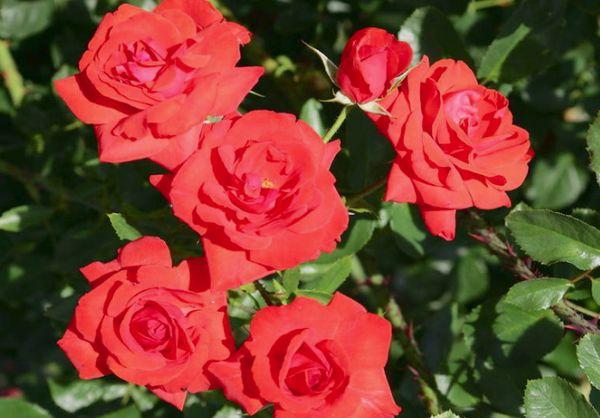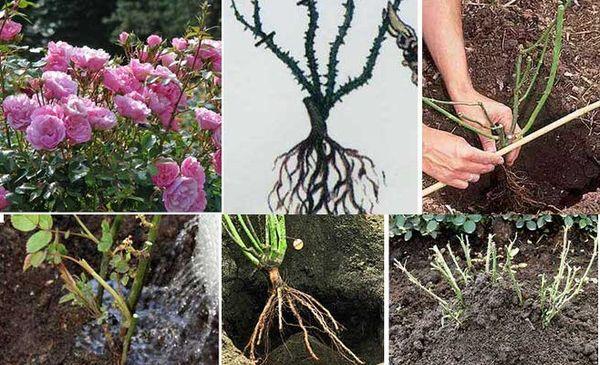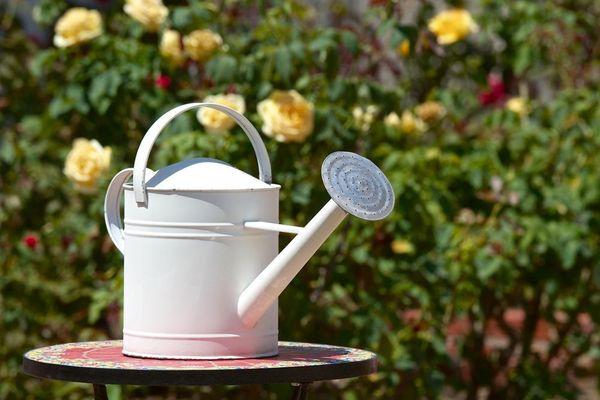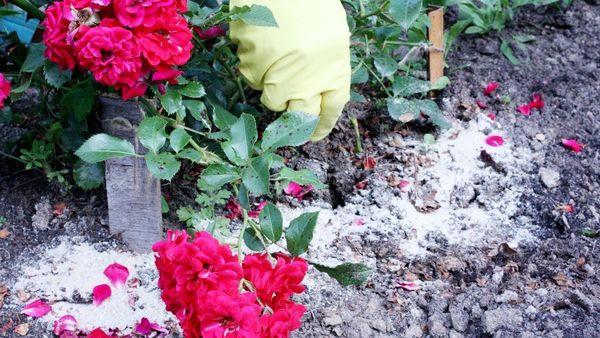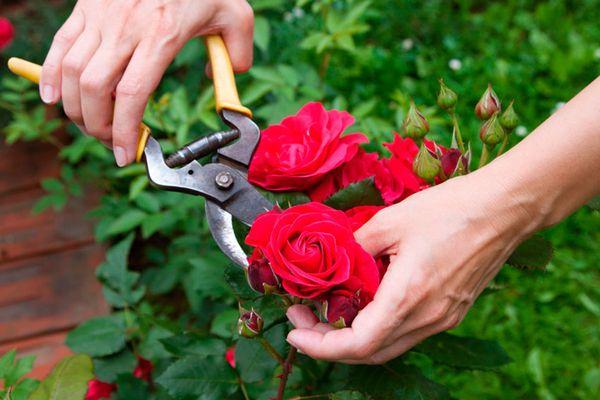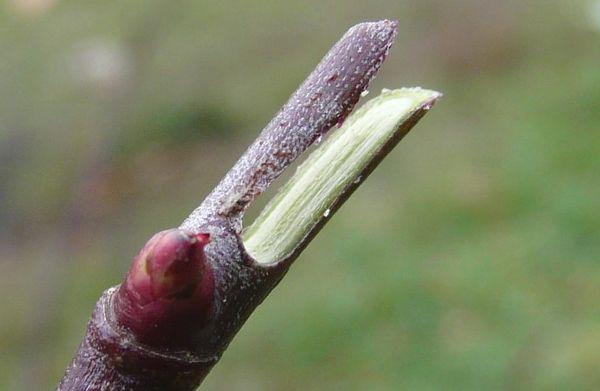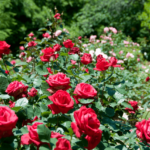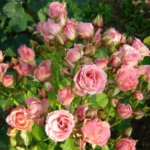Proper bush growing of roses is of concern not only to those who deal with flowers professionally and for sale. Specific tips will be useful to everyone - both amateurs and simply enthusiasts. A distant relative of the rose hip, this species has long become independent. Outwardly unpretentious, the rose bush requires care when planted in open ground. And how to propagate a bush rose so that it grows and develops is a great mystery.
- General description of colors
- Bush rose varieties
- Piano ed
- Red Lex
- Porcellino
- Bombastic
- Freesia
- Iguana
- Calypso
- Advantages and disadvantages
- Landing
- Care Tips
- How to water correctly
- Feeding activities
- Features of transplantation
- Rules for pruning
- How to prepare a bush rose for winter
- Protection of crops from diseases and pests
- Flower breeding
- Seeds
- Cuttings
- Graft
- Dividing the bush
- Layerings
- Application in landscape design
General description of colors
Propagating bush roses in the garden is a fun, exciting activity. The size and shape of plant buds vary widely. The rose bush grows in width, spreading side branches to the sides, or upward, maintaining a pyramidal orientation. There are many well-known varieties of roses, each of which is different from the others. Among the common features that unite the variety of bush roses is a clear gradation of stems into annual and main, uterine ones.
The average height of the bush varies from 25 centimeters to 3 meters. The leaf of a bush rose is elongated, rounded in shape. Along the edge there is a pattern of small teeth. Below it is complemented by a pair of adjacent stipules. Flowers (buds) of a bush rose have miniature petals, containing from 5 to 120 petals.
Combinations of both single buds and those forming an inflorescence are possible, where there can be up to 2 hundred of them. The configuration of the flower remains unique. It is classified as pompom, saucer-shaped, cup-shaped, flat, spherical, peony. The color of the bud also differs among bush roses. It is difficult to find two similar ones; breeders specially work to obtain unique shades.
The only thing that has not yet been achieved is the bright blue color. The spectacle of the delicate buds of a bush rose is mesmerizing and makes the hearts of connoisseurs and florists tremble.
Bush rose varieties
The splendor of species and varieties of bush roses makes it possible to choose any of them, in accordance with your taste and wallet. Bright and discreet, miniature and large, compact and giant, future bush roses are waiting for their buyers from suppliers of planting material.Blooming buds are used in floristry and for decorating garden plots.
Piano ed
A red bush variety, with unusually lush buds (each with up to a hundred petals). The shape is a regular ball, when opened it becomes like a bowl. Belongs to the old English varieties.
Suitable for combined bouquets, in single execution. With a little imagination, such roses, in combination with fruits or berries, make wonderful thematic compositions.
Red Lex
Another red rose variety. Compact, miniature bush rose of a dark cherry shade. The buds are well formed, cup-shaped. Petals with a velvety texture.
Porcellino
The white color of the delicate buds is slightly offset by a creamy note. This bush rose has a unique, delicate aroma, somewhat similar to vanilla.
Bombastic
Bombastic's flowers are curled into dense balls formed by petals. The color combines cream and soft pink shades. Often used together with other bush varieties, emphasizing the splendor of the bud.
Freesia
A yellow, frost-resistant bush variety. The buds smell like ripe fruit. Blooms profusely from June to October. Rose bushes are small, up to 80 centimeters tall.
Iguana
The unusual configuration of the rose bud (it is goblet-shaped) provides this variety with a clear advantage. The exterior of the rose is complemented by a bizarre color transition of the petals - from rich red to burgundy.
Calypso
The color of the buds of the rose variety is dark red, like raspberries. The buds are densely intersected with light lines. The bushes are tall, up to several meters. The aroma is delicate, barely perceptible. The form of flower formation is a whip.
Advantages and disadvantages
Bush varieties of decorative roses are extremely popular among gardeners, and there is a completely logical explanation for this. Or rather, several. This is dynamic flowering combined with plant growth, a delicate aroma, inflorescences collected from many buds.
Climbing and wattle varieties provide worthy material for bouquets and decorative compositions. In addition, in the overwhelming majority, bush varieties are distinguished by their resistance to cold, endurance, and resistance to diseases and pests.
But with these advantages, there are also disadvantages. The rose needs to be pruned, fed, and cared for. And there are still sharp, needle-like thorns protecting the buds. There is nothing complicated in the care itself; after learning the simple rules, even a beginner can cope with it.
Landing
Everyone wants to know how to prepare a bush rose for planting, what is needed for this. The best time, intended by nature itself, for this procedure is autumn. At the same time, seedlings are not purchased in advance, but immediately before planting. Select healthy, undamaged rose bushes without traces of pests.
The next stage is determining the location for the rose garden. Areas near trees and other shrubs are not suitable. Roses need light and warmth, and for this they choose an open, not shaded place. Swampy soil with close groundwater will be a bad solution.
Roses of any variety definitely need drainage. Acid balance is important. The pH level should be between 6-6.5 units. It is advisable that roses and related plants have not previously been grown on the selected site.
Care Tips
A set of recommendations for caring for a rose includes advice on how to plant a cutting, how best to propagate it, how to cover it for the winter, and what to feed the plant for full flowering.How quickly the rose will take root in a new place and how it will feel in the future depends on the systematic implementation of them.
How to water correctly
The rose does not particularly need moisture; rather, it painfully tolerates increased watering. The following method has been determined empirically: water rarely, but abundantly. Newly sprouted seedlings especially need moisture; they are watered at intervals of 2 days. This life support scheme is used during the first year of the plant’s existence. In spring, more moisture is consumed, at which time leaves and young shoots form.
They do the same in the summer, especially in hot climates. Approximate proportions are 10 liters of water per rose bush. The liquid should get into the root zone, while the shoots themselves should not be exposed from the earthen clod. Watering with cold water is unacceptable, only with warm and, preferably, settled water. At the end of the season, when the growing season ends, the flow of liquid is reduced to protect the rose from possible stagnation and fungal development.
Feeding activities
The bush rose is an ornamental plant, more so than its wild ancestor, which needs a supply of nutrients. It is recommended to start active nutrition from the second year, using the following step-by-step algorithm:
- Double the dose of fertilizer applied in the spring.
- The appearance of cones, the development of buds on the bush.
- Completion of flowering.
- Transition of stems from plant to woody state.
It is permissible to combine spring pruning of roses with the application of fertilizers. A mixture of ammonium nitrate and ammonium sulfate is suitable for this. After about 15 days, fertilizing is repeated. To stimulate the ovaries, a complex consisting of superphosphate, nitrate and potassium salt is used, in approximately a ratio of 3:3:1 per square meter of planting.Sometimes such a composition is replaced with a ready-made one - Kemira Universal or similar.
Upon completion of flowering, it will be necessary to restore the balance of minerals; for this, fertilizing with microelements will be useful. At the end of July, the rose is placed on a nitrogen-free diet, stopping the supply of this type of fertilizer. It is allowed to replace mineral mixtures with organics (or their alternate use). Gardeners use burnt ash, manure or bird droppings.
Features of transplantation
Replanting bushes is a normal procedure practiced by gardeners. This is done for several reasons, including due to the natural growth of the rose. The optimal period for replanting is spring or autumn. Moreover, the spring period is preferable.
Before the procedure begins, the bush is freed from diseased, weak, damaged shoots, as well as foliage. The stems are also trimmed to 20-30 centimeters. Excavation from the ground is carried out carefully, trying not to damage the roots. Sometimes it makes more sense to transplant together with a soil ball.
Warm water is poured into a pre-dug hole, abundantly saturating the soil with moisture. The grafted rose bushes are placed so that the scion is covered with a layer of soil of 3-5 centimeters.
Rules for pruning
The main purpose of pruning is to force the rose to actively develop, produce fresh shoots, form lashes and buds. There are 3 periods for the procedure: spring, summer and autumn. First, this is necessary to form a rose bush, then to ensure the growth of shoots.
To do this, all small buds are mechanically removed, leaving a few large ones. In the fall, before the cold weather, the final stage is carried out: damaged parts of the plant and dead shoots are cut off from the rose.
How to prepare a bush rose for winter
The process of pruning bush roses for the winter consists of gradually reducing the amount of incoming moisture (in August), then adding an autumn nutrient complex of fertilizers. The lower leaves are cut off in September, the remaining leaves in October. Before sheltering and hibernating, the rose bush is shortened by removing shoots and stems.
“Wintering” depends on the climatic zone and peak temperatures. They often build a shield pyramid house over the bush, stretching a thick film over the top. If it is impossible to construct such a structure, construct a simpler shelter from film (thick paper), leaving a small gap between the protection and the plant. Sometimes a layer of snow is thrown on top (in severe frosts).
Protection of crops from diseases and pests
Shrub roses, regardless of variety, are susceptible to fungal diseases, powdery mildew, black spot and rust. There is only one protective measure - treatment with fungicides, the merciless destruction of parts of the bush affected by the disease. When there is a lack of iron compounds, the plant develops chlorosis. The deficiency can be easily corrected by fertilizing the area.
In addition to diseases, bush roses are threatened by pests - aphids, mites, cicadas and scale insects. Their appearance will not bring anything good. You should get rid of them immediately using chemicals and folk remedies.
Flower breeding
Varieties of bush roses are propagated by seeds, cuttings, grafting, and division. Each method is justified in its own way and allows you to achieve results - healthy, lush buds on the bush.
Seeds
The method is exotic and of little use, due to the fact that the seeds have low germination. At the same time, it has the right to exist.It is recommended to soak the seeds in a growth stimulant, this will increase the chances of success. Sow shallowly - up to 3 centimeters. Planting roses is mulched with peat and compost. As soon as 2-3 leaves hatch, the bushes are planted.
Cuttings
For bush roses, propagation by cuttings is considered one of the most effective methods. The hardest stems (woody) are selected as “donors”. In this case, the golden mean is important - shoots that are not too green and not too tough. The bottom edge should be oblique; it is advisable to impregnate it with a growth stimulator. The cuttings are planted in open ground, maintaining a distance of 15-30 centimeters. A film is stretched over the top, under which the rooting of bush rose seedlings continues.
Graft
Traditionally, bushes of wild roses (rose hips) or dog varieties (Rosa canina) are used for grafting. The rules are standard: remove the lateral shoots from the root collar of the bush, make a “T”-shaped cut. The scion (bud) will be inserted into it. The average development time of a grafted bush is 3 weeks. After this, based on swelling or blackening, one can draw a conclusion about the results of the procedure.
Dividing the bush
The original method of dividing a bush is applicable to plants with a complete root system. 2 times a year, in spring or autumn, it is allowed to divide a pre-selected rose bush into several parts. At least one stem and formed roots are left on each fragment. Next, parts of the bush are planted as usual.
Layerings
To obtain layering for all varieties, the stem is bent to the ground (placed in a shallow trench), secured and covered with earth. The upper part is left above the ground and tied to a peg. As a rule, the cuttings take root, becoming an independent bush.The method helps to rejuvenate the rose bush, stimulate plant growth and bud setting.
Application in landscape design
Bush rose buds and a variety of varieties are an excellent basis for experiments in the field of landscape design. And if you combine low-growing and tall bushes, with different branches filled with flowers, the effect will be even more significant.
Gardeners braid arches with bush roses and form flower beds from them. It turns out very beautiful and spectacular.


